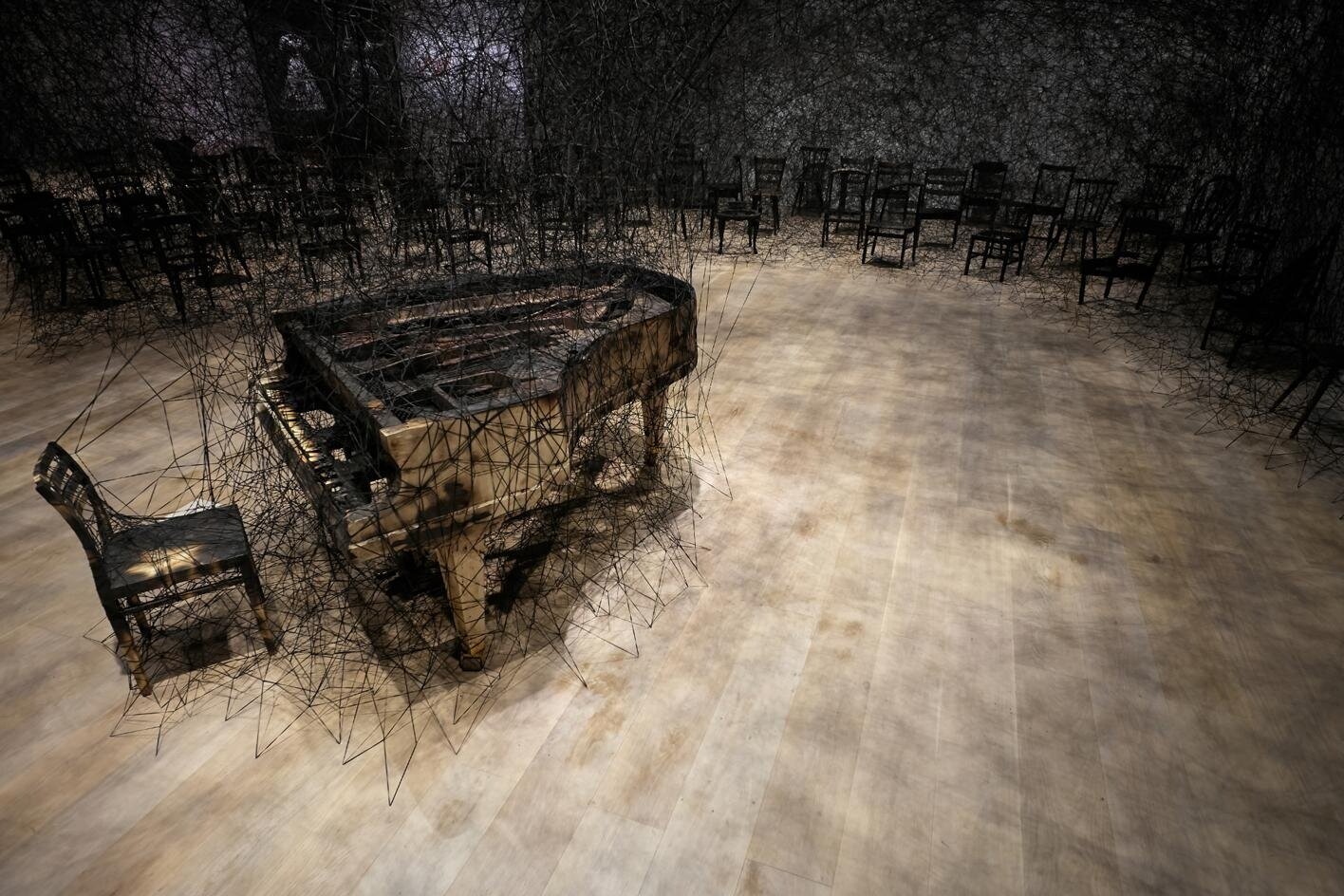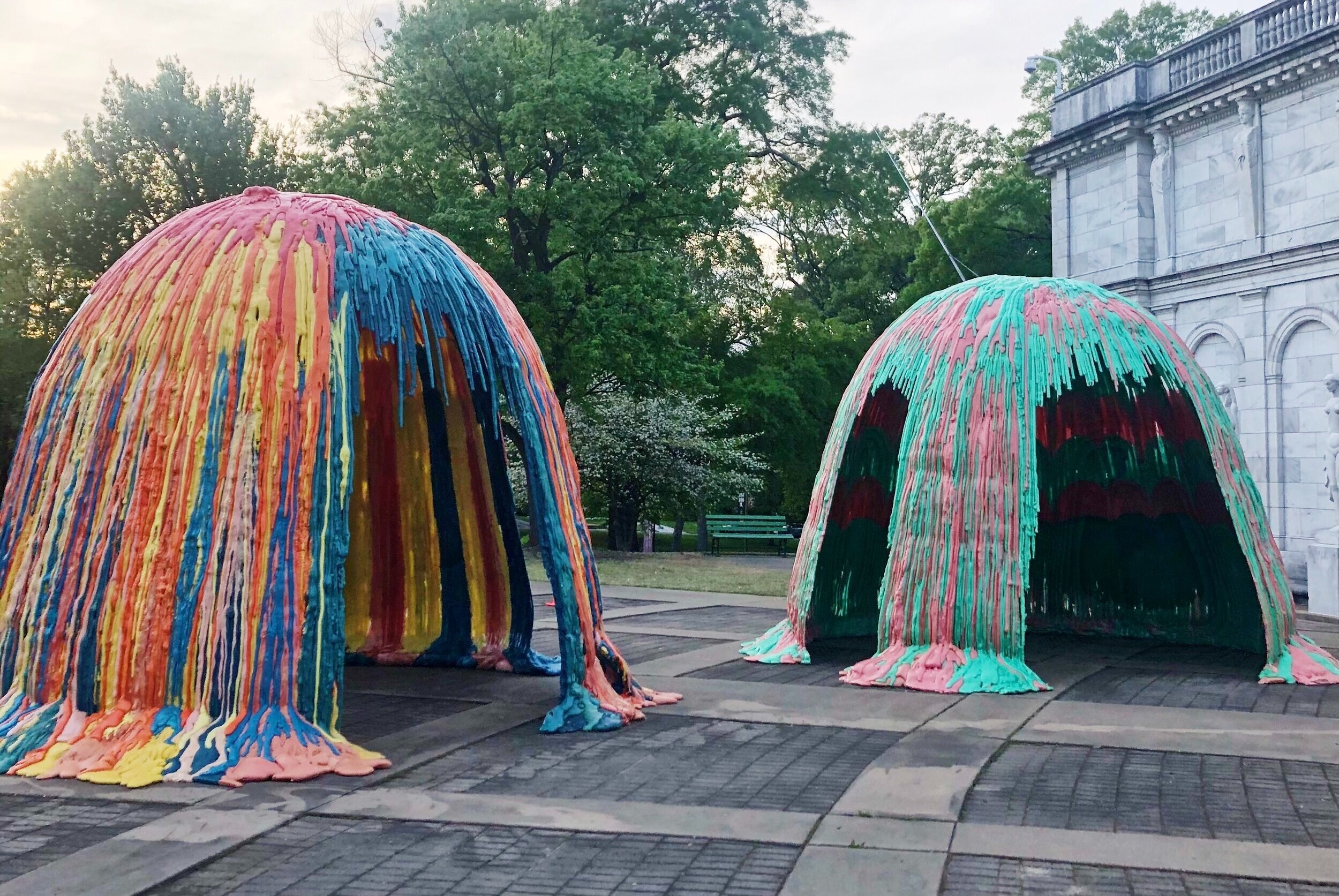In our digital age, art is EVERYWHERE. With the rise of technology and social media, viewing art has become extremely accessible to all. It feels impossible to avoid seeing art in any capacity in our day-to-day lives. It exists in museums, galleries, streets, and more recently on our screens. Therefore, if art is everywhere; how does it capture our attention? A popular answer to this question is art installations. Installation art is one of the most eye-catching and “Instagrammable” forms of contemporary art. The Tate defines installation art as a term describing large-scale, mixed-media constructions, that are often site-specific and temporary. In recent decades, installation art has blown up. Why is that? By exploring the history and nature of installation art, this question will be answered.
Kurt Schwitters, Merzbau, 1937, Hanover, Germany
The term installation art was not officially in use until the 1960s, but precursors to the art form came about in the early 20th century. One of the earliest examples is Kurt Schwitters’ Merzbau of 1937. This work of art was constructed using eight rooms of Schwitters’ house. Each room contained assembled panels of wood that gave the illusion of forms growing outwards from the walls. The house was destroyed in 1943 as a result of a British air raid of Hanover, and the only evidence of Merzbau’s existence comes from the photographs taken of the house. The controversial Dada artist Marcel DuChamp followed Schwitters’ lead and created Mile of String in 1942. This piece was set in a gallery space and was made up of three miles of string devouring all of the open space in the gallery and turning the space itself into artwork. Although both Schwitters and DuChamp were early inspirations for installation artists, many art historians recognize Allan Kaprow’s Yard of 1961 as the first art environment. Kaprow filled the backyard of a New York gallery with tires and tarpaper-wrapped forms. Visitors were encouraged to run, jump and play in the tires, transforming this work of art into an interactive environment. This experiment opened the gates for the immersive and transformative art environments that we know today and are frequented by millions every year.
Chiharu Shiota, In Silence, 2019, Mori Art Museum in Tokyo, Photography: Sunhi Mang, © DACS, London, 2020 and the artist
So, why have art installations become so popular in recent years? Let’s start with their size. Almost every art installation is monumental in size. It often consumes an entire space making it extremely immersive. Whether it is in a gallery space or outdoors, art environments force the viewer to notice them. Chiharu Shiota’s In Silence (2008) is a wonderful example of the effects of scale. This piece features a burned grand piano playing to an empty audience of other burned chairs. The piano and chairs are engulfed in black string creating an overarching web of mesh. The mesh creates the visual illusion that music is coming from the silent piano in the form of string. The pathways through the installation are created through gaps in string making them feel like tunnels in this dark and daunting environment. This large-scale installation contributes to the eerie tone of Shiota’s piece. The overwhelming back strings appears as though it is about to engulf the viewer into its darkness. Without the enormous scale of In Silence, the tone would be lost on the audience.
Ernesto Neto, SunForceOceanLife, 2020, Museum of Fine Arts Houston, Photography: Albert Sanchez, © 2020 Ernesto Neto
Ernesto Neto is another popular installation artist who creates large-scale and interactive art environments. One of his most recent exhibitions is located at the Museum of Fine Arts Houston and is titled SunForceOceanLife. This piece is a long and winding pathway suspended in the air made up of plastic balls and crocheted textiles. Audiences are invited to walk through the pathway to enjoy a tactile and sensory experience. Its warm colors and crisscross patterns make the audience feel as though they are walking through a coral reef. The idea of interacting with art is an essential part of many art installations. It allows for audiences to better understand the piece and feel apart of its purpose. Humans are literally consumed by the immense volume of SunForceOceanLife.
Tadashi Kawamata, overhead view of Over Flow, 2018, Museum of Arts, Architecture, and Technology, Photography: Bruno Lopes
View of Over Flow from below
Furthermore, art installations are almost always mixed media pieces. The medium can often dictate the tone of the piece. It makes the work intriguing and often transforms ordinary materials into extraordinary works of art. For example, Tadashi Kawamata’s Over Flow of 2018 filled the Museum of Arts, Architecture and Technology in Lisbon with plastics and nets found on Portugal’s beaches. This piece can be viewed from multiple perspectives. Seen from above, it appears as a boundless expanse of garbage floating in the water. From below, the viewer is covered by a net holding the garbage with a sinking ship piercing the net. The shadows generated by the plastic ooze into the room creating an illusion of water. The mixed media transforms the work of art into an alarming yet ethereal experience. The beauty resulting from devastation is exhilarating.
Random International, Rain Room, 2021, Sharjah, U.A.E.
With the ever-evolving technical advances of our modern era, new mediums are constantly arising. One fascinating example is the Rain Room created by Random International in 2012. This art installation allowed for visitors to walk through rain without getting wet through the use of sensors. Rain Room uses natural materials (water) to create an unnatural experience. Furthermore, Rain Room was a huge hit on social media. Although this art piece was created before Instagram became extremely popular, photos and videos were constantly being taken by the participants. This installation opened the floor to “Instagrammable” art experiences such as Culturespace’s immersive digital Van Gogh exhibit or Meowwolf’s House of Eternal Return.
Dustin Klein, 2020, Robert E. Lee Statue, Richmond, VA, Photography: Alexis Delilah (@alexis_delilah)
Additionally, many art installations are also site-specific. Artists will sometimes adapt a site and use certain aspects of it in their piece. Other times, they will simply create works of art that will complement the space. Either way, the site of the art environment is very important to the message and reception of the art installation. One influential artist of 2020 was Dustin Klein, who projected various digital images of fallen Black Americans on the Robert E. Lee statue in Richmond, Virginia. These projections pasted “BLM” on the body of Robert E. Lee and images of George Floyd, Brianna Taylor, Martin Luther King Jr., Harriet Tubman, and many other Black heroes on the pedestal. This art installation used the site of the last Confederate statue on Richmond’s historic Monument Avenue to call upon the statue’s history and its role in the suppression of Black Americans, further communicating the artists’ powerful message. Many artists around the world have similarly used projections to transform historically significant sites into the backdrop for important political messages, furthering the importance of art installations.
Ball Nogues, Pour Me Another, 2021, Memphis Brooks Museum of Art
Other art environments such as Ball Nogues’ Pour Me Another outside of the Brooks Museum in Memphis, Tennessee used the site to enhance the piece. Ball Nogues used an inflatable bubble as the canvas for the paint poured repeatedly onto the surface of the bubble. After hundreds of layers of paint hardened, the artists popped the bubble to create an open interior space. People were able to walk into the paint sphere and see the paint from the inside. They were given an insight into the physicality of paint and the process of creation. The bright, eye-catching colors popped against the classic white marble of the museum’s building. The durability of the paint allowed for the installation to be interactive and withstand the outdoors, making this the perfect site for these whimsical paint homes.
It is also important to note that Pour Me Another was a temporary art installation. The ephemerality of art environments is a key component in making them so popular. The temporality makes the installation exclusive. It rushes visitors to the doors to see this almost “once in a lifetime” experience. One of the most popular installation artists of all time is Yayoi Kusama. Her work is often displayed in a room or a space box. One of her most well-known art installations is “Aftermath of Obliteration of Eternity”, which is part of her Infinity Mirror Rooms series. This piece uses mirrors and hanging lights to create the illusion of being engulfed in lights in a dark room. However, when one enters the room there is only a few minutes to experience the lights; they will eventually turn off. Even the experience is a temporary one. Her Infinity Rooms have travelled all over the world and often have lines around the block to witness the boundless array of lights. Effective and memorable art installations combine all of these aspects (monumental size, interesting mediums, site-specificity, and temporality) to create captivating and interactive experiences for the public.
Yayoi Kusama, Aftermath of Obliteration of Eternity, 2009, Hirshhorn Museum, © Yayoi Kusama
One of the controversies surrounding art installations is the question of their categorization. Can art installations be considered fine art? If something is temporary or public, is it fine art? If a piece cannot be bought and sold, is it fine art? Some art enthusiasts would say no, an experience is not a work of art. However, I would argue that art installations are the future of fine art. Just because something cannot be bought and sold and exists in a temporary time frame does not diminish its value. An experience can be just as valuable as a million-dollar painting sold at Sotheby’s. Many would say that Tadashi Kawamata’s Over Flow is a piece of fine art because of the important message that it is making about the environment, or that the technology used to create the physical euphoria of the Rain Room brings a whole new experimental element to the art world. The innovation and interactive nature of art installations make them exciting to a diverse audience. Many people who would never think to visit a museum or gallery flock to see a Yayoi Kusama piece or a Ball Nogues installation because they are unique and approachable. With the rise of social media, art installations will become an even more important part of the art world because of their aesthetic appeal to a camera. Anyone who enjoys taking an ”artsy” photo will tell you that the popularity of art experiences will continue for years to come.
From Staff Contributor Caitlin Cooner
Sources for further reading:
https://www.tate.org.uk/art/art-terms/i/installation-art#:~:text=From%20the%201960s%20the%20creation,on%20ideas%20rather%20than%20objects
https://www.thecollector.com/what-is-installation-art/
Kurt Schwitters:
https://www.tate.org.uk/research/publications/tate-papers/08/kurt-schwitters-reconstructions-of-the-merzbau
Marcel DuChamp:
https://www.tate.org.uk/research/publications/tate-papers/22/duchamp-childhood-work-and-play-the-vernissage-for-first-papers-of-surrealism-new-york-1942
Allan Kaprow:
http://allankaprow.com/about_reinvetion.html
Chiharu Shiota:
https://www.alcantara.com/artists/chiharu-shiota/
Ernesto Neto:
https://www.mfah.org/exhibitions/ernesto-neto-sunforceoceanlife
Tadashi Kawamata:
https://www.azuremagazine.com/article/tadashi-kawamata-over-flow/
Rain Room:
https://www.theguardian.com/artanddesign/2019/aug/13/rain-room-offers-art-lovers-and-instagrammers-the-perfect-storm
Dustin Klein:
https://mymodernmet.com/light-projections-robert-e-lee-memorial/
Ball Nogues:
https://www.brooksmuseum.org/ball-nogues
Yayoi Kusama:
https://hirshhorn.si.edu/kusama/infinity-rooms/











